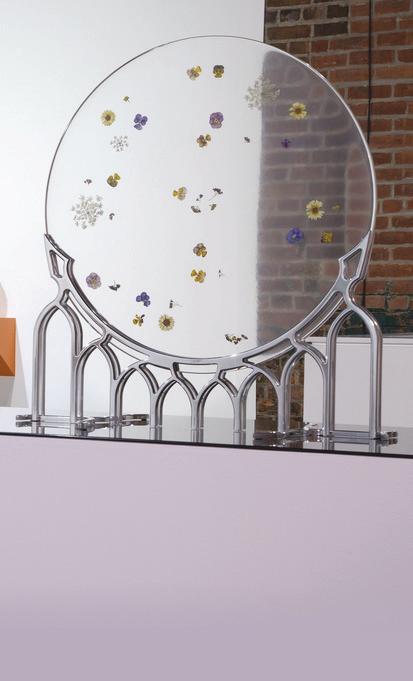
3 minute read
Never Normal
ARTS&LIFE ART
Miasma Mirror, 2020
Advertisement
ASSERMAN PROJECTS W
New exhibit at Wasserman
Projects showcases pandemic-inspired work.
SUZANNE CHESSLER CONTRIBUTING WRITER

Jacob Saphier
Jacob Saphier and Ian Klipa reacted to the pandemic in the way they usually react to a known environment. They designed and fabricated a related three-dimensional piece for an interior space.
The Wasserman Projects in Detroit reacted to the piece in the way gallery administrators usually react to admired works, even during a pandemic. They put it on display.
“Miasma Mirror, 2020,” which artistically showcases past and current crafted materials believed to cope with pandemics, is among works by 20 designers in Never Normal, a group exhibit in collaboration with Form&Seek, a platform that creates, curates and sells uniquely crafted products.
The theme of Never Normal, on view through Dec. 12, explores personal connections to the domestic landscape.
“The prompt of the show is such a good way to explore how design and furniture can create a sense of change or accommodation to a new way of living like the one that we’re in right now,” said Saphier, who partners with Klipa in developing furniture and fixtures as they operate Donut Shop, a design studio in Detroit.
“We typically work in a much more commission-based realm, where everything is being made much more functional for retail or restaurants or someone’s home so this was an opportunity to create something that had more of a statement behind it.”
The statement is based on the idea of the sneeze guard as a quick-fix divider, but the artistic version does not allow viewers to see through it to accentuate the separation. Viewers can see into the piece, which contains dried flowers, recalling the 1800s-era “miasma theory” that disease was caused by noxious odors combatted with pleasant fragrances brought into masks by herbal and floral scents.
Instead of a mirror, a see-through epoxy resin was used to form the piece. Flowers were collected, dried and cast into the resin. All sides are finished, and the way to discern the front from back is seeing the front of the flowers.
Pedestal display provides a complete impression of the piece.
Working together on specific projects is everyday for Saphier and Klipa, who met while attending the University of Michigan School of Art and Design and who have been in the Detroit business community for over four years.
“We’ve created a good symbiosis together,” said Saphier, 27 and single. “Even when we’re creating something on our own, it’s never really on our own because we’re always there giving input to each other and offering different ways that something could be designed or made.”
Saphier, who grew up in New York anticipating an industrial design career, followed that intention with his first professional job as a design engineer in the auto industry.
“I was missing the creative side of things and left that job without much of a plan,” he said. “Ian was working freelance as a metal worker, and I started doing more stuff on my own like Ian was doing and helping other craftsmen.
“After about half a year, because Ian and I were in the same boat, there was a decision to come together and start what today is Donut Shop, a name chosen because we like donut shops and believe they have pleasant associations for others. A lot of our craft and fabrication background has been self-taught through work experience.”
To connect with the creative community in Detroit, the two are active with Design Core Detroit. Their artistry, in the form of a steel chair, was displayed last year during New York Design Week and in 2018 through an entry in Sukkah x Detroit.
“I have plenty of furniture I designed that I use in my own home,” said Saphier, who enjoys celebrating Jewish holidays with family back in New York. “Some are pieces made in school, and some are products that have been discontinued.
“When I create commission work, I make it and send it away. There’s this nice aspect to keeping pieces that I made and seeing how they age. It’s like product research.”
In terms of design, Saphier views a pandemic as a starting point for new approaches to the built environment.
“Although the miasma theory was wrong, it led to a movement away from dank alleyways to more spaced-out courtyards,” he said. “With current health issues and climate change, I believe there will be larger changes in how our spaces are designed.”
To view Never Normal, which will be shown through Dec. 12 at the Wasserman Projects in Detroit, arrange for a private showing by calling (313) 8183550 or access it digitally by going to artsy.net/show/ wasserman-projects-never-normal.










